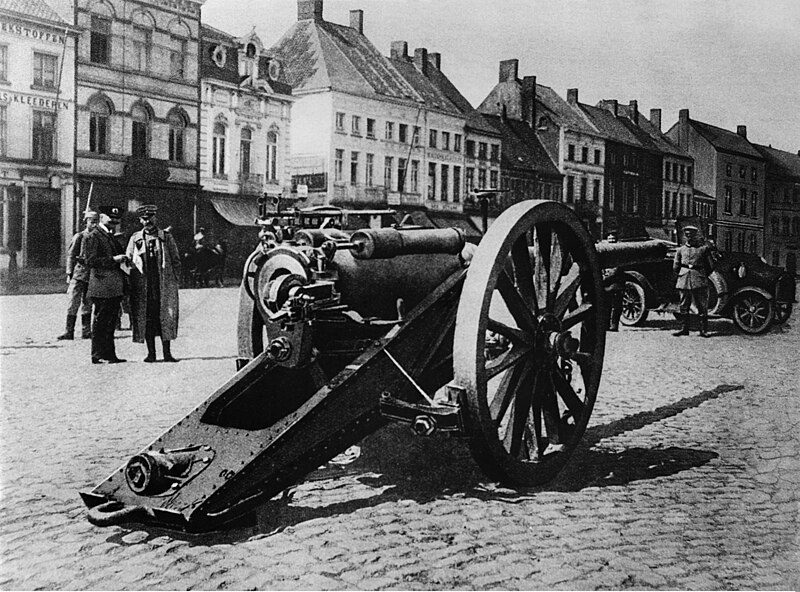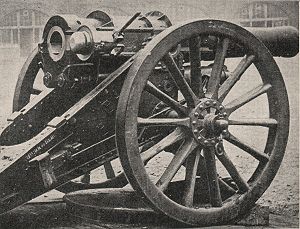Before the war, "heavy batteries" fulfilled the role of "general purpose heavy artillery" and were considered the most important artillery units in the British army. Twenty-six heavy battery units existed at war's outbreak. In contrast, the lighter-armed "siege batteries" were regarded as "specialized units" to be utilized only in specific situations. Only eight siege batteries existed prior to the war's outbreak, and none accompanied the British forces that departed for France in August 1914.
 |
| Heavy battery in action on the Western Front. |
The siege battery thus became the most common field artillery unit created during the war. A total of six units were mobilized in August 1914. By 1916, there were 221 siege batteries in existence. In comparison, the number of heavy batteries increased at a much more modest pace - from the initial 26 to approximately 130 -over the same time period. As the war moved into its final two years, the BEF actually disbanded several heavy battery units in order to create additional siege batteries.
 |
| CEF siege battery on the Western Front. |
 |
| QF 4.7 inch gun mounted on a carriage. |
The "60 pounder" BL Mk I field gun became the preferred heavy artillery weapon of the war. It was first introduced in 1904 after the Boer War demonstrated the need for a heavy, long-range support weapon. Its 127 mm barrel could fire a 27.3 kg shell - shrapnel or HE (high explosive) - a maximum distance of 9.4 kilometres. However, the weapon was available only in limited numbers during the first two years of the war.
 |
| BL Mk I "60 pounder" in action at Gallipoli, June 1915. |
The long range capability of the heavy battery's weapons proved effective in targeting areas behind the German front lines, disrupting the flow of supplies and reinforcements. However, the difficulty of dismantling and transporting such large guns made them much less effective on the battlefield. In addition, the 60 pounder, like all "high velocity" weapons, was most effective in attacking "point targets" that possessed "a pronounced vertical face", such as buildings or high walls. They were not suited for the task of destroying such "flat" targets as trenches, barbed wire and artillery positions. These weaknesses explain the gradual but dramatic shift away from heavy batteries toward siege batteries during the first two years of the war. The siege battery's main weapons - the 6 inch and 9.2 inch howitzer - proved to be much more effective on the battlefield.
At the beginning of the war, the BL 6 inch 30cwt howitzer was the most common weapon deployed by siege batteries. First introduced in 1896, the "back loaded" (BL) medium howitzer was quickly adopted by the British Army. The designation "30cwt" refers to the weight of the barrel and breach - 3507 kg. The gun utilized a recoil system of springs mounted beneath the barrel. Placed on a simple gun carriage (an axle and two wheels), it had no "traverse" (side to side) capability without physically moving the entire unit. Maximum barrel elevation was 35 degrees, which limited its range.
 |
| BL 6 inch 30cwt howitzer. |
An improved design - the 6 inch 26cwt howitzer - was developed in 1915 to replace the older 30cwt. While only slightly lighter, the new model featured an improved hydro-pneumatic recoil system, a traverse that allowed the gun to rotate 4 degrees to the left or right, and an elevation range from 0 to 45 degrees. The 26cwt was capable of firing a 45 kg shrapnel shell a distance of 8.7 kilometers. Lighter weight, 39 kg shells increased the range to 10.4 km. The weapon was also capable of firing a pure HE shell, previously used only in heavy battery weapons.
 |
| 6 inch 26cwt howitzer in action (1918). |
The 6 inch 26cwt howitzer became the "work horse" of British artillery, firing a total of 22.4 million rounds on the Western Front. It was used well into World War II before being replaced by more modern guns. While the 6 inch howitzer was a vital resource on the battlefield, as the war progressed it was gradually replaced by a newer, more effective gun - the BL 9.2 inch howitzer.
Based on the German-designed Skoda 9.45 inch gun used during the Boer War, the BL 9.2 inch howitzer became the main "counter-battery" weapon employed by British forces during the First World War. British industry began work on a redesigned model in 1910, with the focus on reducing the Skoda's high minimum elevation. The first British prototype was tested in Wales in 1914 and production commencing the following year. The prototype, affectionately nicknamed "Mother", was shipped to France in August 1914 and put into action early the following year. By the end of 1915, the 9.2 inch howitzer had become the weapon of choice for front line siege batteries.
 |
| 9.2 inch BL Mk I howitzer in action (1917). |
The 9.2 inch howitzer also employed a newly designed, hydro-pneumatic recoil system that quickly became the standard for subsequent British artillery guns. While the initial Mk I model had a relatively limited range of 9186 meters, an improved Mk II model employed a longer barrel and heavier maximum propellant charge, increasing range to 12 800 meters. The gun's shorter barrel length, adopted to make the weapon more mobile, meant that it rose into the air when fired. To compensate for this problem, an "earth box" was attached to its front and filled with 9 tons of soil.
By the end of 1916, 230 of the newly designed 9.2 inch howitzers had been delivered to artillery units in France. The gun gradually replaced the 6 inch howitzer as the preferred siege battery weapon, and was capable of firing an estimated 2 rounds a minute. The barrel of the Mk I model had a predicted life of 6000 combat rounds, while the improved Mk II model fired a higher velocity shell that reduced its lifespan to 3500 rounds. Both guns fired HE (high explosive) shells filled with Amatol, Trotyl (TNT) or Lyddite, weighing 290 pounds (132 kg) apiece. During the last year of the war, the 9.2 was also used to fire mustard gas shells, although only a small quantity - 7000 shells - was produced.
*****
Sources:
Artillery of the Great War. Landships. Available online.
BL 9.2 inch Howitzer. Wikipedia: The Free Encyclopedia. Available online.
Gudmundson, Bruce. The British Army on the Western Front 1916. Oxford, England: Osprey Publishing (2005).
QF 4.7 inch Gun Mk I - IV. Wikipedia: The Free Encyclopedia. Available online.
No comments:
Post a Comment